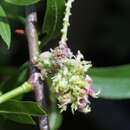More info for the term:
swampBlack willow is most common on river margins where it occupies the
lower, wetter, and often less sandy sites. It is also common in swamps,
sloughs, swales, gullies, and drainage ditches, growing anywhere light
and moisture conditions are favorable [
5]. It flourishes at or slightly
below water level and is not appreciably damaged by flooding and silting
[
5,
16]. On a flooded site in southern Illinois, black willow survived
32 or more days of complete inundation [
16]. Black willow, however, is
not drought tolerant. Whole stands may die out when water tables lower
and soil dries up [
39].
Soils: Black willow grows on a variety of soils but develops best in
fine silt or clay in relatively stagnant water. It thrives in saturated
or poorly drained soil from which other hardwoods are excluded [
6,
24].
Black willow is commonly found in moderately acidic (lower pH limit is
4.5) to near neutral soils [
5].
Climate: Black willow grows best in climates characterized by an
average annual rainfall of 51 inches (130 cm), with approximately 20
inches (51 cm) falling from April through August. The average maximum
temperature across its range is 93 degrees Fahrenheit (34 deg C) in the
summer and 59 degrees Fahrenheit (15 deg C) in the winter [
5].
Plant associates: Black willow is commonly associated with the
following species: eastern cottonwood, red maple (Acer rubrum), black
spruce (Picea mariana), river birch (Betula nigra), American sycamore
(Platanus occidentalis), boxelder (Acer negundo), red mulberry (Morus
rubra), swamp privet (Forestiera acuminata), buttonbush (Cephalanthus
occidentalis), water elm (Planera aquatica), and American elm (Ulmus
americana) [
5,
39].

